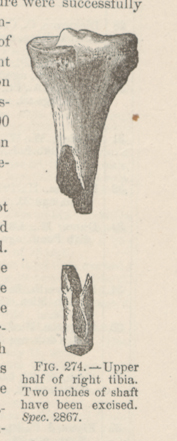Title: Heath, L.
Source text: The Medical and Surgical History of the War of the Rebellion. (1861-65.), Part 3, Volume 2 (Washington, DC: Government Printing Office, 1883), 449.
Civil War Washington ID: med.d2e18726
TEI/XML: med.d2e18726.xml
CASE 711.—Sergeant L. Heath, Co. D, 2d Michigan, aged 22 years, received a shot fracture of the right leg, before Petersburg, June 18, 1864. He was admitted to the field hospital of the 3d division, Ninth Corps, where excision was performed but not recorded. Assistant Surgeon A. Ingram, U. S. A., contributed the pathological specimen, shown in the annexed cut (FIG. 274), with the following report: "The patient entered Judiciary Square Hospital, Washington, July 1st, with a wound about the junction of the upper and middle thirds of the tibia. Resection of about two inches of the continuity of the bone was performed on the day of the injury. The tibia was somewhat shattered for about an inch above and below the points of resection. Amputation at the lower third of the thigh was performed in this hospital on July 7th, by Acting Assistant Surgeon J. H. Thompson, the condition of the injured parts and the constitutional state of the patient rendering the operation necessary. The circular method was chosen and ether was used as the anæsthetic. Tonics and stimulants were administered after the operation. Hæmorrhage to the amount of six ounces occurred from the femoral artery on July 12th, when the vessel was taken up in Scarpa's triangle. Death occurred from pyæmia July 28, 1864. The specimen (No. 2867, Surg. Sect.) consists of the upper half of the injured tibia and shows the extremities to be somewhat irregularly necrosed.
